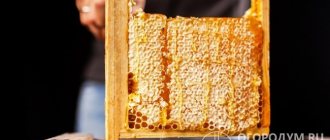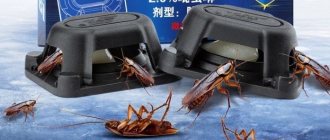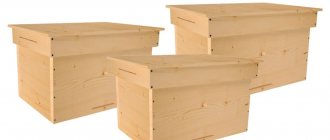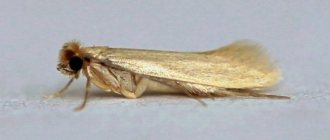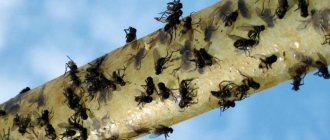Blog articles Beekeeping
Beekeeping
Economics of beekeeping
Beekeeping news in Russia
Beekeeping news in the world
Honey
Propolis
Bee bread
Zabrus
Royal jelly
In the world about bees
Apiary
Bees
News from honey fairs
From the history of beekeeping
- Catching swarms
- What is a bee trap and why are they needed?
- Where to place the trap?
- Instructions for installing a trap
- How to make a bee trap with your own hands?
- Proper making of insect traps
What it is?
In the beekeeping field, traps are various devices made from artificial or natural materials and designed to attract stray/ wild bees. The shape of such traps can be different, but most often they are square or rectangular boxes made of plywood or EPS.
Another do-it-yourself bee trap is often made from a log (the tree species most common in the region is used), then the design is cylindrical in shape. A cavity is created inside the trap for 5 frames , although often the number of frames increases to 6 or even 8 pieces. Thanks to this, the effectiveness of the device significantly increases, because bees, in search of new hives , usually give preference only to the largest objects. Each bait is equipped with only one entrance with a bolt. After insects populate the bait hive, the entrance is closed, and the “captives” are transferred to the apiary .
On a note ! Beekeeping is one of the most ancient economic sectors. Despite the fact that beehives were invented only in the 7th–8th centuries BC, primitive man was also successfully involved honey
Instead of a preface
If this is your first beekeeping season, then for a more complete understanding of the picture, we recommend reading the article “What is bee swarming and how to deal with it”
There is no need to be afraid of swarming. This is not some kind of evil attack or disease, this is a normal phenomenon in the bee colony. It’s somewhat similar to how grown-up children leave their parents’ home. The young swarm flies out of the hive, but will remain nearby for some time. This moment cannot be missed. The beekeeper’s task is to promptly provide the young bee colony with a normal home - a trap. In this way, he will maintain the number of families in the apiary and will not incur additional costs. Believe me, a good, strong family is worth more than a wooden box, which, in essence, is a bee trap. This is a simplified version of a hive for temporary residence.
When the swarm settles into the swarm and more or less calms down, it is moved to a normal, high-quality hive, suitable for wintering.
If you skip swarming, then a new, formed swarm with a young queen will fly away after some time far from the old nest in order to avoid overcrowding and nectar starvation. But if you manage to do everything on time and correctly, then the young bees will mistake the swarmers for their new nest.
Question : Why catch wild swarms?
Answer : how why? To avoid buying new bees. After all, you can catch them for free. Well, it's free of charge. You will spend some money and time on making a bee trap, placing it correctly and checking it periodically. Additional bonus: a good harvest of wild honey. Another reason to use traps to catch wild swarms is to strengthen weak colonies in your apiary.
What’s good about wild swarms is that you don’t have to think about whether they are suitable for a given climate or whether they will work well on the honey plants that are in the area. Wild bees already live in this climate and work on the honey plants that are available. If they are still alive, then everything will be fine when they move to the apiary.
Attention: never move wild swarms to your own immediately after capture. First, treat them against ticks and other diseases if you don’t want to get the whole bunch of troubles for yourself.
Features of making a bee trap with your own hands
You can make bait from almost any material you have at hand. You can also use even a well-dried log for this, as noted earlier, but such work will require first-class carpentry skills and a lot of free time. Therefore, in this article we will look at some of the simplest options.
Before starting work, clearly determine how far the trap will be from the apiary; this distance will affect the size and volume of the structure. If the apiary is located next to meadows or forests, then the bait is made quite large - at least 8 hundred . Such traps are two-tier structures that allow you to catch several bee colonies at once.
If there is no optimal place nearby, the trap is made mobile, on one tier. The small structure can be quickly moved to another location without much effort. It also provides bees with a space of about 50 liters.
Expert opinion
Ponomarev Sergey Stepanovich
Beekeeper with 30 years of experience, Candidate of Technical Sciences
A new colony must be protected from “thieves” from neighboring apiaries, otherwise it may be completely destroyed by a larger bee colony.
When to check and remove
Equally important is monitoring the condition of the “trap”. In most cases, it is recommended to check traps every 7-10 days. This mode allows you to control the swarm until you return for a new check. That is, even if the swarm appears in place immediately after leaving, there will be just enough space for laying eggs in 7-10 days before returning.
Experienced beekeepers recommend removing the trap in the late evening or early morning, since during this period of time there is no gathering of bees to pick up all the residents. This fact must also be remembered when the system is returned to its old location, since old bees can interfere with the settlement of a fresh swarm. If the structure is located far from a permanent apiary, then beekeepers recommend moving the structure in the opposite direction from the apiary for several days. This approach will prevent the bees from returning to the place where the bait was once located.
Do-it-yourself half-frame trap
Let's start with the fact that a structure of this type does not have a very large volume, but bees, due to their unpretentiousness, will populate it too. the drawings below to create a half- frame
But first, let's talk about what materials are needed.
- The bars are made from any dry and tolerable wood (it can be pine, spruce).
- To make the roof, bottom and walls you will need plywood 4 mm thick.
- The lid additionally needs to be covered with some kind of material to prevent moisture from getting inside the trap. It is better to use thin sheet metal or galvanized steel; polyethylene and roofing felt will last for several seasons, but will cost less.
- The shape of the taphole can be any (or the same as in our drawings).
- Self-tapping screws will also be required to assemble the structure.
- For painting, it is advisable to use acrylic paint (it does not smell and dries quickly enough).
This is a general view of the design of a magazine half-frame .
Assembly drawing of the trap
And this is an assembly drawing of the end of the structure.
Assembly drawing of the end of the trap
The bars in the example have a cross-section of 15x20 mm and different lengths. Before screwing a self-tapping screw into a block, we recommend drilling it with a thin drill first in order to eliminate the risk of splitting.
Drawings for bars for the trap
Bars for the trap
Last fragment of drawings
Plywood, as noted above, should be 4 mm thick. You should not use fiberboard without special protection due to its high hygroscopicity, just like fiberboard or cardboard.
Trap end
Side of the trap
Bottom of the trap
Trap roof
Note ! Such a trap will be cheap. A couple of sheets of plywood are enough for 5 structures. Another similar trap can be used to store magazine frames, or as cores .
Primary requirements
When making traps and placing them, there are a number of conditions that must be taken into account:
- the bee trap will be left outdoors for a long time. It must withstand precipitation and not break under the influence of wind. For manufacturing it is better to take plywood or fiberboard. These materials are light and quite durable;
- The bars that serve as the frame of the structure are best placed inside the trap. The location of the bars on the outside contributes to the accumulation of moisture in places that are difficult to dry and leads to premature damage to the walls;
- To prevent swarm traps from being conspicuous, khaki camouflage with spots and stripes is used. Thus, protection against theft is provided to some extent;
- ventilation should be provided in the box. The structure is essentially a small hive that temporarily houses a swarm;
- The frames should be firmly secured so that they do not move when removed from the tree and transported. To do this, a bar is nailed on top of them;
- traps are placed at a distance of one and a half kilometers or more from the location of the apiaries. It has been observed that bees prefer free-standing trees;
- the trap should be spacious, with a volume of 40 to 70 liters. It should contain from 4 to 8 frames;
- It is extremely important that the bee trap has a strong scent. Scout bees follow this smell, and they pass it on to the colony. It could be propolis, lemon balm, burnt wood. Swarms are well attracted by placing old black sushi. But bees react poorly to a recently painted product. The smell of paint is unpleasant to them, and it disappears only after a year;
- They try to simplify the design as much as possible. To protect from rain, polyethylene is placed on top of the lid and stapled on the sides;
- A logical question may arise: how to make a bee trap lighter? You can reduce weight by removing the cover. To do this, install horizontal strips between the upper bars of the frames. The bees find themselves isolated from the upper space. It turns out to be a ceiling, on top of which a pillow is placed, and on top of it is dense polyethylene, which is fixed to the side walls.
DIY trap for 6 Dadan frames
This trap is lightweight, inexpensive and simple in design. swarms large enough to cover 6 Dadan frames.
DIY trap for 6 Dadan frames
What materials will be required to assemble such a trap:
Plywood 4 mm thick
Nails or screws
Bars of different lengths 15x30, 15x20 and 15x15 mm
Tin, galvanized or roofing felt
Anyone can assemble a 6-frame design using the Dadan system without any problems. Among other things, the finished box can be used as an apiary frame for 6 frames.
Look at the general appearance of such a structure.
General view of a 6-frame trap
And this is an assembly drawing of the end. The taphole shape ; in our example, it measures 10x100 mm.
Assembly drawing of the end of the trap
Check out the drawings of the bars. Before screwing a self-tapping screw into a block, we recommend drilling a thin hole in advance to eliminate the risk of splitting the wood.
Drawings of bars for a 6-frame trap
Below are drawings of plywood parts. The required plywood thickness is 4 mm. You should not use fiberboard without a protective coating due to its high hygroscopicity, as well as fiberboard or cardboard.
Drawings of plywood parts
Note ! You should not skimp on material, since high-quality plywood, if painted well on the outside, can last at least 10-12 years.
Varieties
Hive Dadanovsky 12-frame.
In addition to the main types, there are hives:
- Alpine. Does not have a ventilation system or grilles. Consists of several buildings. Doesn't take up much space.
- Dadanovsky. Coniferous trees are used in construction. Widely distributed among other bee dwellings.
- Plywood. Inexpensive option for a house. Construction does not take much time, the service life is long.
- Cassette. This type allows the bees to independently regulate the temperature in the hive. It cannot be painted, it can only be treated with hot wax.
- Plastic. The lightweight design is easily transported from one place to another and does not deteriorate during long-distance transportation. The hermetically sealed walls of the housing do not allow wind and precipitation to pass through. Quickly done with your own hands.
- Northern. The name speaks for itself. The optimal temperature for bees is maintained inside the hive. In the most severe frost, bees do not freeze.
- Asian. Designed for small numbers of bees.
The beekeeper determines which hive is suitable for bees. All types of bee houses can be built with your own hands.
In the drawing of the future bee house, it is necessary to describe the construction technique. In appearance, the hive is similar to human housing. It has a roof and a main frame with an entrance for bees.
It is recommended to make several drawings:
- General. Shows the finished product with dimensions.
- Construction technology.
- Dimensions of individual parts.
- Assembly.
The drawings must show the location of the boundaries between blocks. If it is not possible to make a drawing yourself, you can use the services of builders or experienced beekeepers.
When pumping out honey, you need to be extremely careful not to harm the larvae, otherwise the queen of the hive may sting the beekeeper.
Master Class. An example of making a simple bee trap
Let's consider a budget option for making a trap, which has been done many times and successfully tried.
Simple bee trap
Step 1 . To work, you will need a minimum list of materials and tools. In the example, the author uses unnecessary slats, tape, a jigsaw, garbage bags, a stapler and cardboard boxes.
Step 2 . Then the frame of the structure is assembled. The slats are connected using a stapler.
Step 3 . The frame is covered with cardboard. A frame with wax and old drying material is installed. The frames are fixed with a piece of cardboard.
Step 4 . A garbage bag is pulled over the resulting structure, wrapped with tape, after which a tap hole . Actually, this is where the work ends.
Expert opinion
Ponomarev Sergey Stepanovich
Beekeeper with 30 years of experience, Candidate of Technical Sciences
Under the tap hole on the front wall, the author nailed a piece of old, polarized canvas, using the same stapler.
Drawing assignments
To build such a bait, you need to create drawings of a trap for bees. If you have at least a little knowledge of drawing, you can test your own strength in this activity. Read here - Do-it-yourself pump replacement: checking, removing, replacing, installing and testing the pump’s performance (120 photos)
For an understanding person this is not a big difficulty. However, if you do not understand drawings at all, we recommend that you turn to your nearest construction company for help.
Professionals in their field will help you implement your plans, based on your own preferences. It won't take much time and won't be too expensive.
Plus, this way you will never make a mistake in your calculations and will be able to design everything correctly.
Where to install the finished trap?
Experienced beekeepers have their own secret places to set traps, almost always guaranteeing the capture of bees. Typically, insects move along safe and long-explored routes, often due to the specific smell of the area, which attracts a swarm. However, for a beginner, choosing a place for a trap is problematic.
When looking for the ideal location, be sure to consider that a swarm often migrates over very long distances in search of housing. He is looking for a place away from competing bee colonies , but at the same time close to flowering vegetation. Therefore, the trap should be placed away from apiaries (at least 3 km).
Baits are also installed outside populated areas: their pollution, electromagnetic radiation and noise usually scare away bees. Do not forget that setting traps near large lakes is also useless, since insects rarely fly into such places.
Important ! The optimal place would be a flowering meadow or an area near forest groves. Ideally, such a site should be located next to a small flowing body of water. When looking for food, bees always visit places that will guarantee their capture.
Video
We offer several more videos in which beekeepers share their experience in constructing traps for bee swarms and catching them:
About the author:
Stepan Levada An avid gardener, beekeeper and gardener, partial to dogs and cats and other pets. Spends spring, summer and autumn at the dacha and experiments in the garden beds. Loves to communicate with “advanced” summer residents and find something new and useful for himself. Collects the best methods of preparation and recipes for preparing dishes from products grown with your own hands. He is happy to share his discoveries and secrets with readers.
Found a mistake? Select the text with the mouse and click:
Ctrl + Enter
Did you know that: Tomatoes have no natural protection against late blight. If late blight attacks, any tomatoes (and potatoes too) die, no matter what is said in the description of the varieties (“variety resistant to late blight” is just a marketing ploy).
It is believed that some vegetables and fruits (cucumbers, stem celery, all varieties of cabbage, peppers, apples) have “negative calorie content,” that is, more calories are consumed during digestion than they contain. In fact, only 10-20% of the calories received from food are consumed in the digestive process.
A new product from American developers is the Tertill robot, which weeds weeds in the garden. The device was invented under the leadership of John Downes (creator of the robot vacuum cleaner) and works autonomously in all weather conditions, moving over uneven surfaces on wheels. At the same time, it cuts off all plants below 3 cm with the built-in trimmer.
You need to collect medicinal flowers and inflorescences at the very beginning of the flowering period, when the content of nutrients in them is highest. Flowers are supposed to be picked by hand, tearing off the rough stalks. Dry the collected flowers and herbs, scattered in a thin layer, in a cool room at natural temperature without access to direct sunlight.
The homeland of pepper is America, but the main breeding work on developing sweet varieties was carried out, in particular, by Ferenc Horvath (Hungary) in the 20s. XX century in Europe, mainly in the Balkans. Pepper came to Russia from Bulgaria, which is why it received its usual name - “Bulgarian”.
Both humus and compost are rightfully the basis of organic farming. Their presence in the soil significantly increases the yield and improves the taste of vegetables and fruits. They are very similar in properties and appearance, but they should not be confused. Humus is rotted manure or bird droppings. Compost is rotted organic remains of various origins (spoiled food from the kitchen, tops, weeds, thin twigs). Humus is considered a higher quality fertilizer; compost is more accessible.
In Australia, scientists have begun experiments in cloning several varieties of grapes grown in cold regions. Climate warming, which is predicted for the next 50 years, will lead to their disappearance. Australian varieties have excellent characteristics for winemaking and are not susceptible to diseases common in Europe and America.
One of the most convenient methods for preparing a harvest of vegetables, fruits and berries is freezing. Some believe that freezing causes the nutritional and health benefits of plant foods to be lost. As a result of the research, scientists have found that there is practically no decrease in nutritional value when frozen.
Convenient Android applications have been developed to help gardeners and gardeners. First of all, these are sowing (lunar, flower, etc.) calendars, thematic magazines, and collections of useful tips. With their help, you can choose a day favorable for planting each type of plant, determine the timing of their ripening and harvest on time.
The right time to set a trap
In addition to the appropriate location, it is also worth determining the optimal time to set traps. Often insects leave their homes only once, during the swarming . This process is accompanied by the division of a large swarm into families, which fly away to populate new territories.
This usually happens at the end of May, when many flowering plants appear, it is at this time that we recommend setting traps. There is no point in doing this earlier or with the onset of summer; the chance of catching bees in another period is practically zero, but the risk that they will be spotted by ants, hornets or wasps increases significantly. And expelling them from the house is very problematic.
Traps for stray bees
Lures for catching stray swarms
I have already written about propolis and beeswax. There are also modern baits that are designed specifically for catching swarms. These preparations contain substances that have been selected in accordance with the basic instincts of insects. The most effective baits include the following drugs:
- apimil;
- apira;
- sanroy;
- TOS-3
and others. If you are interested in knowing exactly how they work and what is included in their composition, ask in the comments, I will collect everything I have on them in one article, but for now it is enough to know that they work and apply them correctly.
And here's what happens inside the swarm:
How to catch bees correctly?
Bees are quite whimsical, and therefore it is not easy to lure them to the apiary. They cannot stand artificial odors, but they are attracted to sources of honey and other bee products. Therefore, you need to make bait based on propolis, honey and other things.
Important ! The honeycombs and walls (inside) of the structure should be generously wiped with bee products. You can also additionally use thick sugar syrup by covering the honeycombs with it. Remember that in nature bees live in hollows, so the trap must be fixed at a height of at least 3 m.
Honey
Wax
Propolis
Perga
Finally, we will consider the rules for transferring a hive to an apiary.
- Transfer it in the evening, always after sunset . After all, during the day most insects are outside.
- The trap must be transported immediately . Otherwise, the bees will experience severe stress and most of the swarm may die.
- When working with bees, protect them from strong odors (gasoline, household chemicals, perfume, etc.) . They can make insects angry.
See also : Do-it-yourself hive-bed for 24 frames. In addition, you may be interested in the article about the queen bee.
Rovlya swarms
An apiary is a noble and interesting occupation, but not everyone can take up beekeeping seriously. Proper care of bees is an entire art, which can be truly comprehended even a few years after the purchased layering. At first, incidents happen - the bees develop and reproduce in a completely different way than the beekeeper would like. They can fly away in a swarm, and sometimes more than one, if you do not monitor the development of the bee colony as expected - what to do if this happens?
A special bee trap can help you. The trap, or rather the bait in it, lures your own runaways back home, and with great luck, wild or alien swarms of bees living nearby. Among experienced beekeepers, a very popular hobby is often to lure wild insects into traps, which is not easy to do - you need dexterity, experience, and fearlessness of heights and bees. Young beekeepers should not joke with “savages”.

